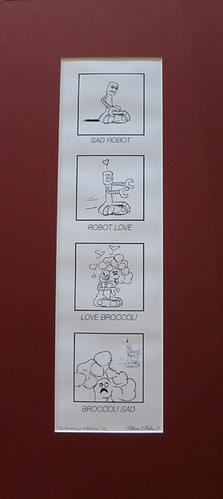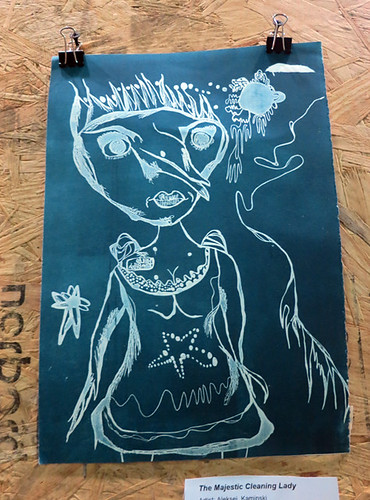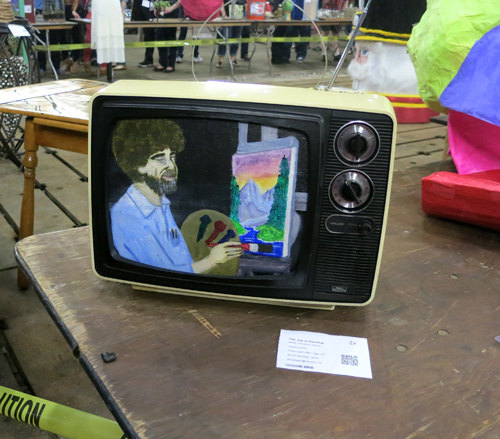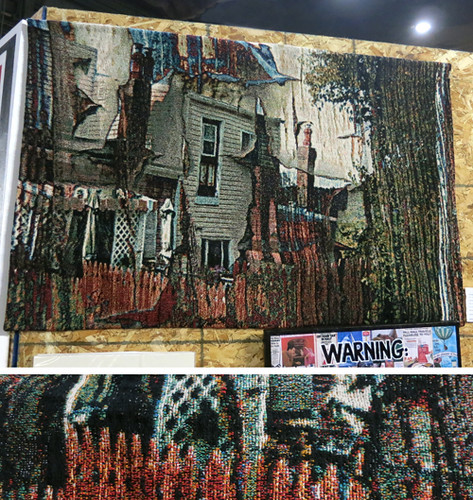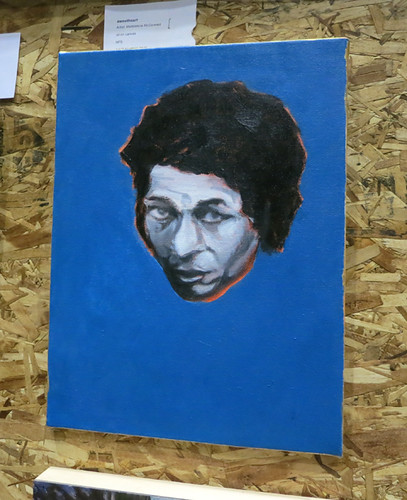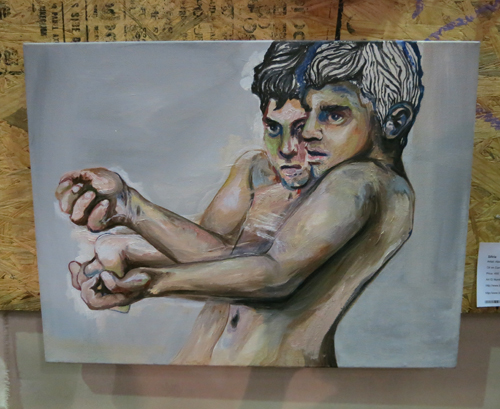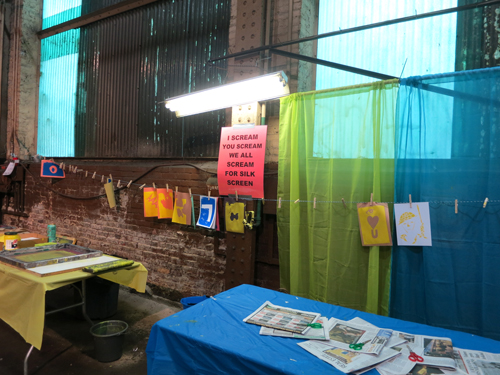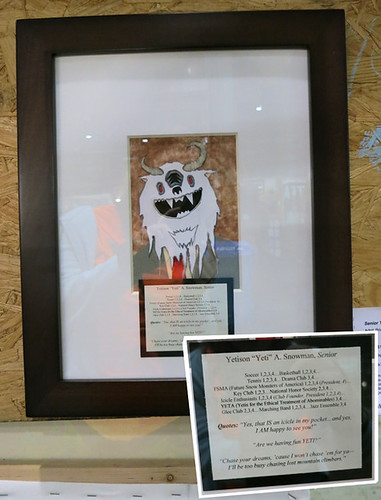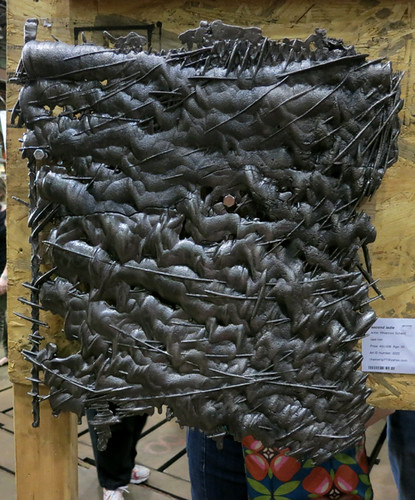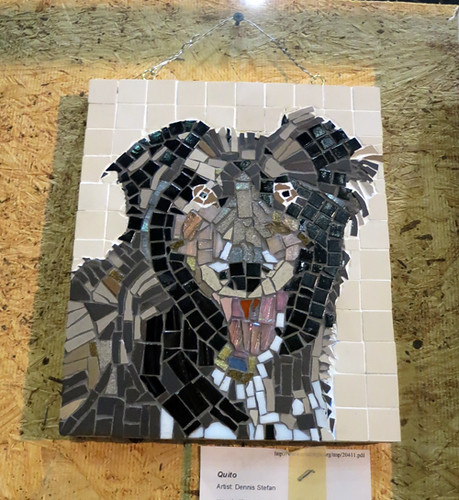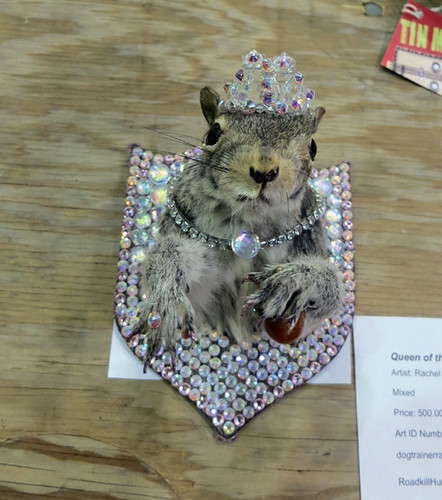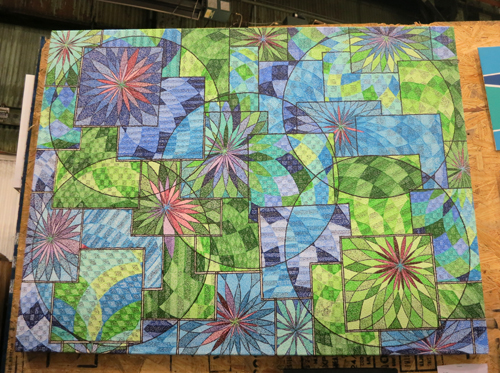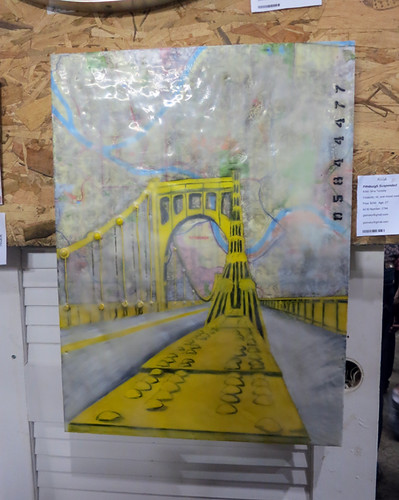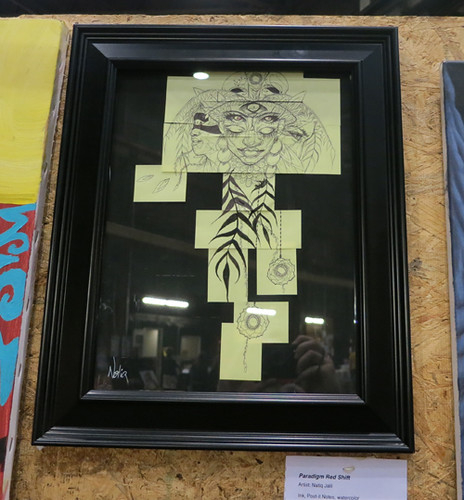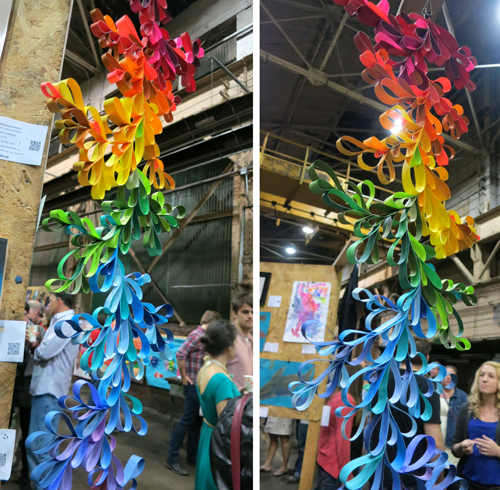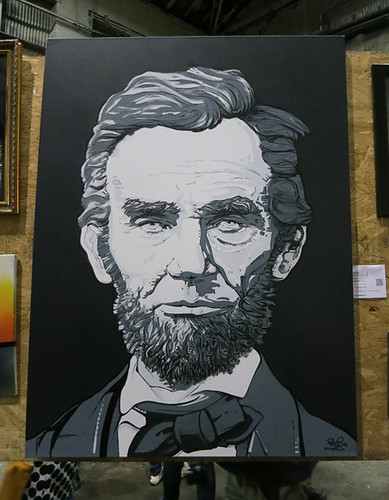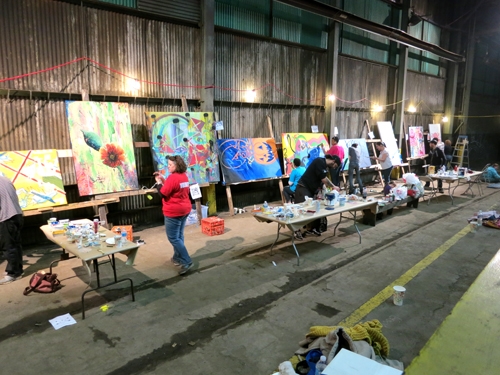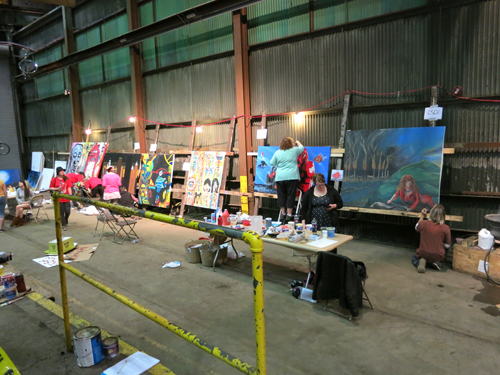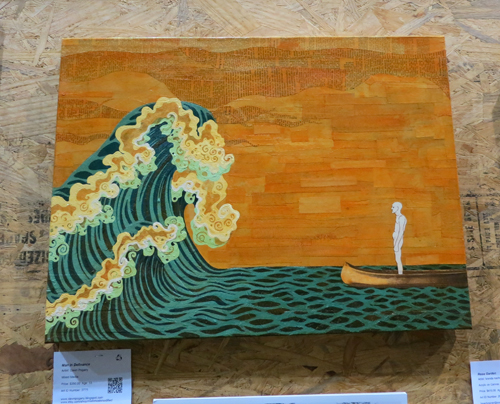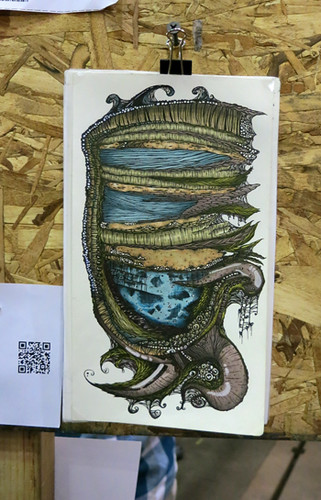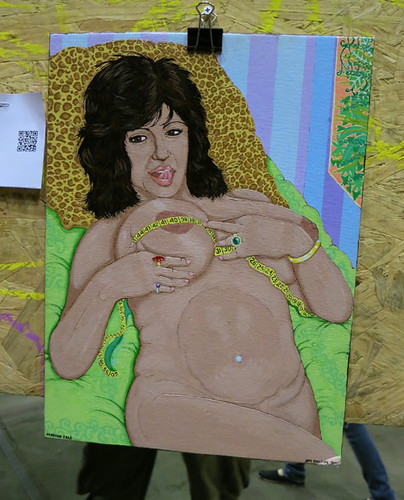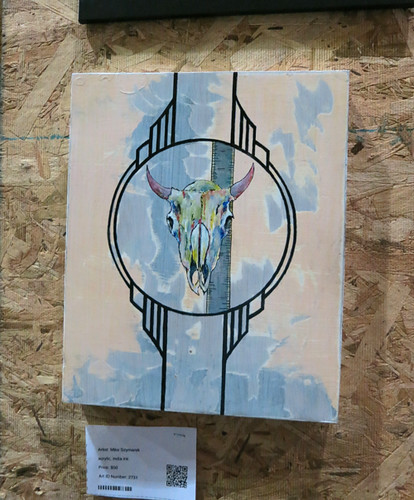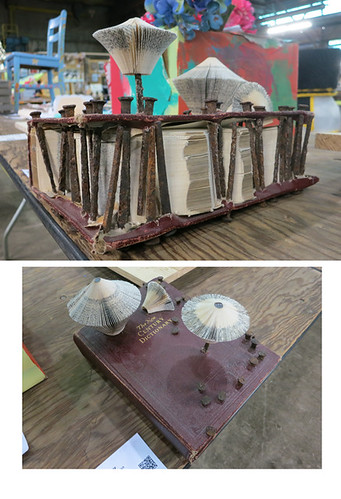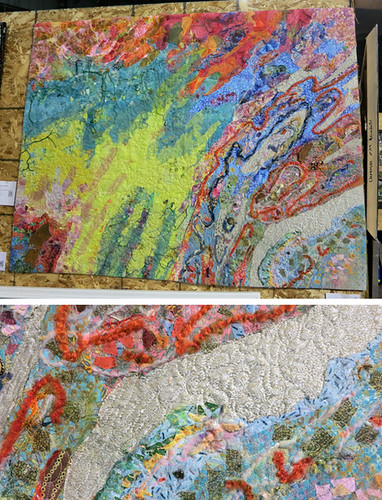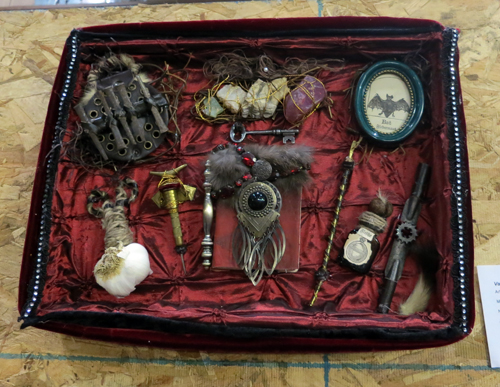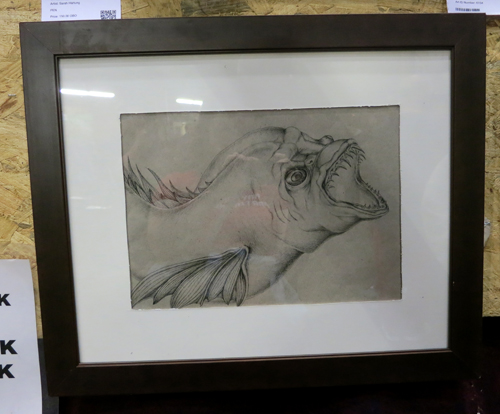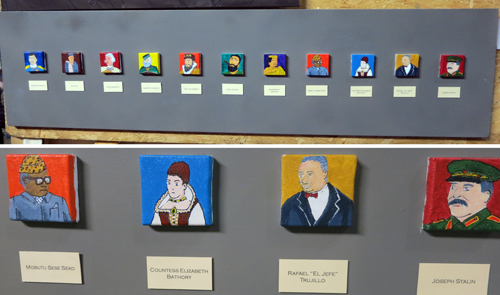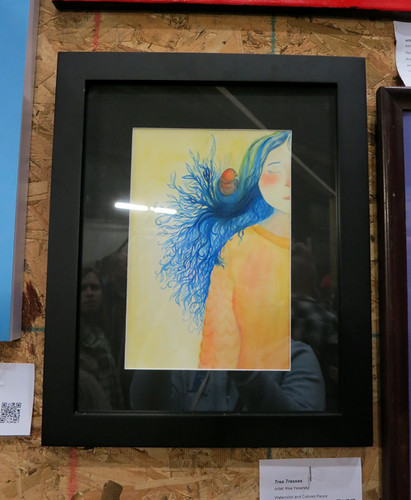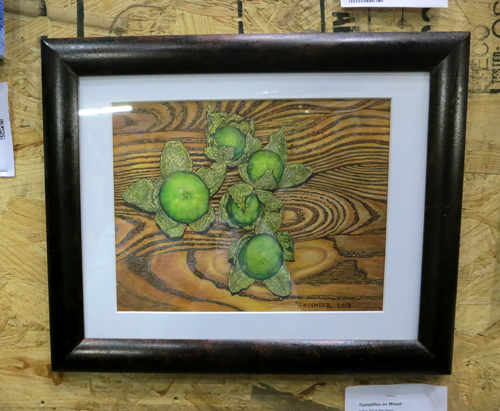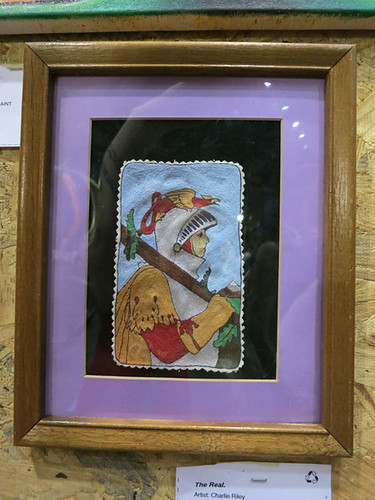Do you have a specific idea of the story you'd like each piece to
tell, or are you hoping viewers will have stories of their own ready to
inhabit your work?
I remember being upset at
times, when a student somewhere would write a paper about one of my
pieces and base their information just on what they saw, rather than
what I’d written in my own statement about that piece. I’ve learned to
let people have their own stories of my work, even if their ideas of
what I was after are all different than my original intent. I know many
people won’t even read one thing on my works, and that others’
interpretation of my symbols will be way off from my own. I can’t waste
my time expecting others to listen to what I say, and it’s a very
creative process, when they take all the crazy disparate things I put
together visually and make their own logic out of it. It’s all good!
 |
I’m staring at the painting, which has a lot of colors on it already and will tell me what it needs where now.
|
Do you have any concrete advice about how to do away with artist's block?
Draw
every day. I invented a little process, in which you go into your
studio and sit down and draw and write whatever comes into your head,
for 10 minutes only, then you quit. I do it with my students, and we
use children’s markers, so they can relax and just play. I call this
Library Time, and no one talks while we work for the 10 minutes. I find
it makes me feel centered into myself really well, and it brings up
lots of creative thoughts, though whatever pops into your head is what
you just let come through. It’s a form of channeling your inner thoughts
and creativity, and you become loosened up. Works like a charm, and
it’s free. No big book to read on how to be more creative. Just do it,
any time you want to get unstuck. Priming the pump!
Do you place a high value on the role of humor in fine art? How do you
attempt to incorporate humorous elements into your own work, and what
would you say is your response when you get a laugh from a piece by
another artist?
I know people sometimes think my work is funny, but I prefer to push it to being edgy, not humorous. I am a little fussy about that, and I don’t like it when people say my work is cartoonlike or whimsical. But I know I have to own those terms, when people see them. So I work to keep the effect I want in my drawing style, which is simplified, not realistic. I think you can fall off the balance of edgy into the abyss of cute or funny really easily, and I don’t want to. But then, that doesn’t sound like I’m just letting my creativity out, does it? We can’t turn off all our thinking, but we can learn to open up and let things come out … even if I do care to make sure my images are not whimsical.
 |
| “American Pie: 6 of Potholders (coins) in the Kitchen Tarot,” full view, ©Susan Shie 2013. Sewn painting on cloth. 60”h x 90”w. Read the long artist’s statement and find many pix of this piece at http://www.turtlemoon.com/gallery13/AmericanPie.htm. |
What do you believe about the role of originality in art? Do you
think it is important to always be unique, or is it best to just make
the work and not worry whether it will be similar to something that
someone else may be doing? Have you ever felt that your work was not
original enough, or conversely, that a desire for total originality was
getting in the way of your work communicating effectively?
I’m
sure I’m obsessed with being original, but at least I can honestly say I
don’t think about it consciously while I’m working, and maybe that’s
true of my need to have my art look edgy and feisty instead of cute. On
a very deep level, I MUST have a look that’s mine. Maybe this comes
from art school, where students learn to never, ever copy each other’s
ideas. Or at least, that is my memory of it. I know I don’t care that
some of my students copy my style. That’s fine, because they paid me to
teach them. Some of them just enjoy working my way, but those who want
to get known for their own look will have to push through all the stuff
they learn in classes and come up with that look.
If someone saw my work and
told me they thought it was someone else’s work, I’d be miserable and
really have to rethink what I’m doing. I want you to recognize my work
among a bunch of artists’ work, every time, once you’ve seen my work.
Yeah, that’s ego for you! But it is truly important to me and always
has been. I don’t need to brag about my art or anything like that. I
just want to know you know it’s mine.
 |
“American Pie: 6 of Potholders (coins) in the Kitchen Tarot,” detail, ©Susan Shie 2013. Sewn painting on cloth. 60”h x 90”w.
|
You made a conscious switch from doing very labor-intensive, physically
complex quilt art to your current more streamlined airbrushed work that
includes only a few carefully chosen embellishments. Do you think the
old way and the new way of working produce or come from two different
states of mind? Do you ever miss the old method, and have you broken
from your current method to make any new work in the old style?
They
are from the same state of mind, in terms of creative motivation, but
along with the taming of the airpen for fabric paint and cloth and the
numb fingertips from hand sewing, I also consciously realized I choose
to be a painter much more than a quilter/sewer. I only miss the old way
of doing all that hand work when I’m riding a long time in a car or
sitting still to watch late night tv sometimes, as I could be sewing.
Except it would wreck my hands, which I try hard to honor by not
overdoing repeated motions. I think the numbness is carpel tunnel
syndrome. I would only do the old style again if someone paid me the big
bucks to do it. My hand stitched and beaded quilted paintings were
$20/sq inch, and my machine quilted paintings are $4/sq inch. I think
the hand work is actually way more than five times the effort though. I
would have to really, really pace myself to do that again, but money
talks! I have a middle size piece frozen at half hand stitched, and I
haven’t been able to stomach finishing it, from when I left it sit in
2006. Instead I restarted a different, much larger piece of the same
Kitchen Tarot piece, using my new methods, and finished it in two
months. I knew it would have taken a half year to finish the smaller
version of “The Food Scales: Justice in the Kitchen Tarot.”
You use an incredible number of personal symbols in your work, and I am
curious about how they have entered into your art over time. Have you
stuck with most of the same symbolic elements for a long time, or are
different meaningful animals, people, objects and patterns continually
coming into your head? Lastly, do you choose them consciously or do they
just sort of start appearing and at some point you realize that a
certain symbol has chosen you?
They
have just kept accumulating over time, and I think I figure them out,
usually very playfully. I think that having to pick a kitchen object to
represent the traits of each Kitchen Tarot major arcana card really
escalated that growth of symbolic vocabulary. Maybe the trickiest one
was figuring out that the pressure cooker could be the Tower card, as I
had to think of something in the kitchen that had been dangerously
ignored and eventually explodes, which is what the Tower card is about.
 |
“Home Blessing Song #1.” ©Susan Shie 2013. Sewn painting on cloth. 12”h x 12”w made for the 2013 SAQA online auction.
|
Your studio is in Ohio, and as far as I can tell, you have a very
un-New-York personality, but I definitely adore one of your pieces that I
saw in "Masters: Art Quilts Vol. 1," "Tropical New York." I'm curious
to hear your thoughts about New York, what it's like to create work
inspired by this city, and urban themes in general.
I
lived in New York City for six months in 1988, on an artist residency
with the Ohio Arts Council, and Tropical New York is about some
adventures I had there, especially when Spring came to the city. Jimmy
brought our daughter Gretchen and two of her friends, all 17 years old,
on their Spring Break, and they stayed in my Long Island City apartment,
3 blocks from my studio at PS #1. Long Island City is on the east bank
of the East River, right across from Midtown Manhattan, one subway stop
away.
I had a big studio in PS #1,
when the studios were still in bad shape, but they were working on the
building. This was WAY before MOMA used PS #1 as its building, while
the museum in Manhattan was being renovated. It was the only time in my
adult life that I lived alone, except for when I had my granny pad in
Cleveland in 2004-06, to take care of Eva at my kids’ house during the
week, while my daughter was at work. The NYC period was full of
exploring the city, making lots of my work, and interacting with artists
from all over the world. I could have stayed there, if I’d had 3 jobs
to cover all the expenses that were paid for me during that amazing
residency!!
 |
“Downtown Wooster Saturday
Morning,” full view, ©Susan Shie 2013. Painting on stretched canvas. Acrylic and
ink. 18”h x 24”w. Collection of Lisa Wagoner, Wooster,
Ohio.
|
I love that piece. It’s from a
more reckless time in my work, when I was doing a LOT of painting with
abandon on lots of crazy fabrics, and I was still using 3-D figures I
sewed together, painted and stuffed and embroidered all over. There are
snakes to represent the subways, some of my first Buddha Girls, to
represent the Voice Meditation class I took at PS #1 with the Dutch
artist’s wife. (There were something like 35 artists who had studios
there, mostly from other countries, but there were 4 of us from US
states. Ohio had one of the best arts councils in the country then, and
still does, but all of them have lost most of the funding they had back
then. They sent me to China for a month in 1990, too!)
 |
“Downtown Wooster Saturday
Morning,” detail view, ©Susan Shie 2013. Painting on stretched canvas. Acrylic and
ink. 18”h x 24”w. Collection of Lisa Wagoner, Wooster,
Ohio.
|
Do you have any extremely talented artist friends whose work you'd like
to plug here on the blog? They don't have to be fiber artists, just
super cool folks who could use a little blog love.
I
love the work of Suzanne Fisher of Cincinnati, who’s a painter, mixed
media artist, and mosaic muralist. Her work is amazing. She also had
an artist residency at PS #1 in New York, the year before me, and we
became good friends over it. To me her work is edgy and often about
women, which is my own thing, too. I have never collaborated with
Suzanne, but would love to!
 |
This is a mosaic fountain by my friend and genius, mixed media artist Suzanne Fisher of Cincinnati. http://suzannefisherart.com/home_main.html
|
I am an artist who "cannot draw," and I am interested in the ways that
artists who want to make work which is representational but not strictly
realistic can develop a visual vocabulary that does two things, both of
which I think your work does very well. The first is communicate
clearly (i.e., figuring out how to draw hand gestures, faces and body
interactions that viewers will be able to read easily even if they do
not conform to the laws of reality). The second is visual appeal (i.e.
why do I adore some artists who work in this style of not strict
realism, like you, Lynda Barry and Pamela Allen but absolutely loathe
other artists' work that can be said to follow the same conventions?). I
would love to hear your thoughts about the importance of communication
and visual appeal within the work that you do.
Thank
you for your supportive words! I believe that art is mainly an act of
communication, and in my life, communication is what it’s all about! I
believe that all of us can draw just fine, but most of us dropped
drawing at some point, so for those many people, their drawing skills
NOW are probably worse than when they quit drawing, as a child.
Children are geniuses in many ways! But they learn to fear being
wrong, and they hate to be ridiculed. They often shut down anything
they don’t have to do, that might get them picked on.
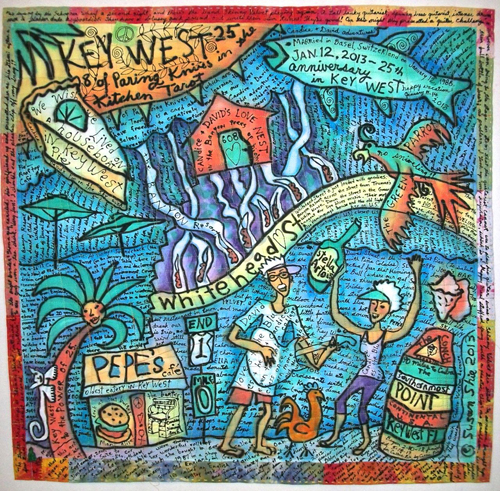 |
| “Key West25 : 8 of Paring Knives (swords) in the Kitchen Tarot.” |
I
used to draw realistically a lot, but I also did a lot of photography,
and finally I decided that my camera can do the realism, while I busy
myself with making more intuitive art. I love to draw, and I know that
if I copy from a sketch I’ve made and love, it gets wrecked with
stiffness. I still make life drawings, looking at things and drawing
them realistically. That’s how you learn! You need to just draw, to
accept what comes out, in order for it to be alive. It’s good to stand
up to draw, to have some music on, to move with that music while you
draw. And especially it’s best to turn on the negative thinking. It
makes me happy to draw and paint and write and sew! I think when we’re
happy, our bodies and minds get a chance to do some healing and
balancing. So then: art is good for you!
 |
“Turtle Moon Sign.” ©Susan Shie 2012. Sewn painting on cloth. 22”h x 24”w.
|
As
for getting the gestures right, it helps to draw from real life when
you can. You educate yourself when you really LOOK at what you’re
drawing. And practice makes perfect! I have many, many years of art
school behind me, and some of that stuff I recognized as balognie: the
rules part. But the golden part was making tons of drawings from life,
developing the skill of being able to communicate what you see. So
then, like a jazz musician, you can scat when you draw. You can
syncopate the look, like how a jazz player stylizes the music, bending
the music rules to their desires. I think what you’re talking about
responding to could be called syncopated drawing. Or Jazzy Art, or
Sassy Art! Sassy is a nice word, and I’ve got a few little classes on
my site I’m now offering with that word in their titles. Sassy Drawing,
Sassy Painting, Sassy Art Quilts, or something like that. It’s making
art with a real sense of freedom many people sadly don’t realize they
would love feeling.
 |
| ©Susan Shie 2008. This is the largest painting I’ve ever made. Hand colored house paint, brushed onto wooden garage door. Approx 8’ x 16’, plus trimwork. Finished about a week before the Presidential Election 2008. Statement and large images at http://www.turtlemoon.com/gallery08/Garage%20Door%20Mural%20full.htm. |
A GIANT thank you to Susan Shie for infinite patience with the ridiculous delay in getting this interview published, it was an absolute pleasure to work with you, and to learn all about your artistic process and your life philosophy!











